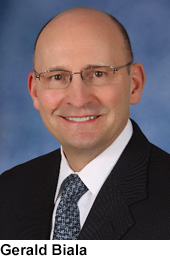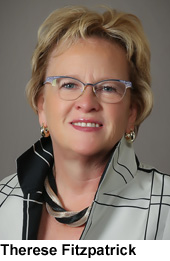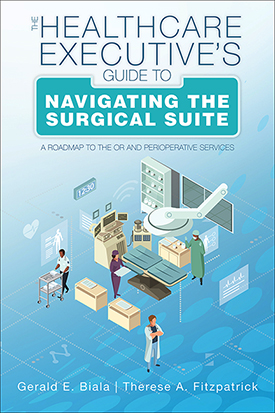Because you can’t administer what you don’t know about.

Gerald E. Biala and Therese A. Fitzpatrick, coauthors of The Healthcare Executive’s Guide to Navigating the Surgical Suite, respond to questions from James Mattson, editor of Reflections on Nursing Leadership (RNL).
RNL:
As they wheeled the gurney up to the double doors of the hospital’s operating suite, they told us: “OK, this is as far as you go. We’ll let you know when your son’s surgery is completed.” I was reminded of that long-ago experience when reading
The Healthcare Executive’s Guide to Navigating the Surgical Suite. It seems that anxious parents aren’t the only ones excluded from operating rooms. Hospital executives also may be shut out and told “This far and no further.” Why is that? How did those expectations get started, and how does this book help change them?
Gerald Biala and Therese Fitzpatrick:
 This is not a fully accurate interpretation of why hospital executives are not as aware of the inner workings of the surgical suite as they should be. Many surgeons, anesthesiologists, and nurses would welcome hospital executives’ getting to know their areas better. The difficulties are more the result of the literal physical barrier required in these departments. Rounding throughout the hospital and meeting with hospital staff have been recognized as best practices for the hospital executive, but time to perform these activities is limited for the busy hospital executive. Just the fact that they need to change into surgical attire to tour the operating room adds additional time to an already limited schedule.
This is not a fully accurate interpretation of why hospital executives are not as aware of the inner workings of the surgical suite as they should be. Many surgeons, anesthesiologists, and nurses would welcome hospital executives’ getting to know their areas better. The difficulties are more the result of the literal physical barrier required in these departments. Rounding throughout the hospital and meeting with hospital staff have been recognized as best practices for the hospital executive, but time to perform these activities is limited for the busy hospital executive. Just the fact that they need to change into surgical attire to tour the operating room adds additional time to an already limited schedule.
 Additionally, the surgical services environment requires strict adherence to aseptic practices, and most hospital executives are not knowledgeable regarding these clinical requirements. Traffic in and out of surgical suites is limited due to risk of infection. So, it is easier and perhaps safer for hospital executives to cut short their presence in these areas. However, they can round on the periphery in the preoperative unit, at the operating room control desk, or in physician or staff lounges.
Additionally, the surgical services environment requires strict adherence to aseptic practices, and most hospital executives are not knowledgeable regarding these clinical requirements. Traffic in and out of surgical suites is limited due to risk of infection. So, it is easier and perhaps safer for hospital executives to cut short their presence in these areas. However, they can round on the periphery in the preoperative unit, at the operating room control desk, or in physician or staff lounges.
RNL: Mark Taylor, past president and CEO of a large health system, writes of The Healthcare Executive’s Guide to Navigating the Surgical Suite, “This book cracks the code on how to bring improvements to a part of the hospital that far too long has been literally and figuratively closed to senior leaders.” In writing a book that introduces hospital executives to a secret world within the world they administer and know little about, what are some of the key messages you seek to communicate?
Biala and Fitzpatrick:
Hospital executives need to be more engaged with surgeons, anesthesiologists, and nursing staff to understand their unique challenges when responding to the impact of the changing healthcare environment. Surgeon practices require nursing staff to maintain deeper knowledge and competencies for their more complex cases, which call for significant growth and development programs. These activities often compete for time in meeting high productivity targets. Surgeons and anesthesia personnel require highest levels of efficiencies to ensure no time is wasted, yet resources to achieve these efficiencies are often reduced to save costs.
Time spent with these practitioners will help the executive understand challenges firsthand, without relying solely on interpretation from department leaders. They can ask the “tough” questions that may not be able to be asked by members of the surgical team, who recognize the need to preserve relationships. The executives’ participation on surgical services management committees can then be more effective in problem-solving and providing best resources to achieve necessary goals.
RNL:
Besides the responsibility they have for watching the financial bottom line, are there legal considerations healthcare executives need to be aware of that make reading this book worth their time? If so, identify how your book can help them avoid some of those potential liabilities.
Biala and Fitzpatrick:
Ensuring quality of care comes to mind in responding to this question. The hospital executive needs to learn the critical interventions and processes required by surgical services to ensure highest quality of care. Cutting corners in these areas may reduce operational costs at the risk of compromising patient outcomes. Legal experts have learned about these critical elements and use this knowledge for their investigations of potential malpractice.
Another legal consideration is choosing tactics to financially engage physicians in improving department performance and cost-saving activities. Knowledge of legal and regulatory boundaries or limits in how these co-management arrangements are structured is essential to meeting these strict requirements.
RNL:
Mandy Richards, chief nursing officer of a hospital system, states: “The work that is laid out in this book is like a recipe for success in managing the complexities of surgical services. … [In our surgical services department], the most impactful decision was implementing a PEC structure.” What is a PEC structure? Briefly identify key elements of a PEC structure and why people such as Mandy Richards find implementing such a structure useful.
Biala and Fitzpatrick:
 The Perioperative Executive Committee (PEC) is a shared decision-making body given the responsibility and authority to manage resources and enforce policy in the surgical services environment. Membership includes the surgeon and anesthesia medical directors, departmental nursing leadership, and hospital executives responsible for surgical services. These members are most acutely aware of the complexities and dynamics of making management decisions and how those decisions impact the patient, the hospital’s financial performance, and its “surgical services community.” Without this management structure, decisions are made individually by a variety of leaders without benefit of group discussion—or by executives who lack knowledge of their impact.
The Perioperative Executive Committee (PEC) is a shared decision-making body given the responsibility and authority to manage resources and enforce policy in the surgical services environment. Membership includes the surgeon and anesthesia medical directors, departmental nursing leadership, and hospital executives responsible for surgical services. These members are most acutely aware of the complexities and dynamics of making management decisions and how those decisions impact the patient, the hospital’s financial performance, and its “surgical services community.” Without this management structure, decisions are made individually by a variety of leaders without benefit of group discussion—or by executives who lack knowledge of their impact.
RNL:
The two of you wrote The Healthcare Executive’s Guide to Navigating the Surgical Suite. When you were first assigned responsibility for the surgical area, you didn’t have this book to help you navigate. How did you acquire the knowledge you share in this book? Any stories you’re willing to share that could be titled, “If I knew then what I know now …”?
Biala and Fitzpatrick:
There are very few college courses that cover operating room patient care or management of the surgical services department. Often these are covered in only a brief lecture. There are journals dedicated to surgical services that have published excellent articles and studies on management. But our literature search only found one book published in the 1980s on the topic.
So, those who choose to work in this area must gain their knowledge from experience. Certainly, knowledge transfer of good management practices does occur, but understanding how to apply that knowledge comes from on-the-job training or postgraduate education.
RNL:
Things have changed dramatically in recent decades. Outpatient and specialty surgery centers have taken “business” from hospitals that once did it all. Surgical science has evolved. The ideal is to collaborate effectively despite competition to provide optimal clinical outcomes. How does your book help promote professional working relationships among business competitors while advancing optimal healthcare for the patients they serve?
Biala and Fitzpatrick:
The book reviews several tactics to partner with physicians in co-management arrangements and as investors in ambulatory surgery centers. The chapter on understanding surgeon and anesthesia practices is a beginning for understanding how to work with these physicians. This supports improved interaction with physicians when there are opportunities to work together in meeting the needs of the surgical patient population.
Further, the book provides an introduction to fundamental understanding of how the surgical services department functions. With this knowledge, the hospital executive can ensure resources are provided and managed to achieve optimal patient care.
Gerald E. Biala, MSN, RN, CNOR, CSSM, is a surgical services management consultant and managing partner for Precision Consulting Services Inc. and senior vice president of implementation services at Sullivan Healthcare Consulting. His expertise stems from 40-plus years of healthcare experience focused on care of the surgical patient and related clinical support areas, including serving as surgical services director in both academic and community settings.
Therese A. Fitzpatrick, PhD, RN, FAAN, is a senior vice president and member of the Performance Improvement Practice at Kaufman Hall Associates, assistant clinical professor at the University of Illinois-Chicago College of Public Health, and a faculty member at Augusta University’s College of Nursing. She is coauthor of Claiming the Corner Office, published by Sigma Nursing.
Click here to purchase The Healthcare Executive’s Guide to Navigating the Surgical Suite.